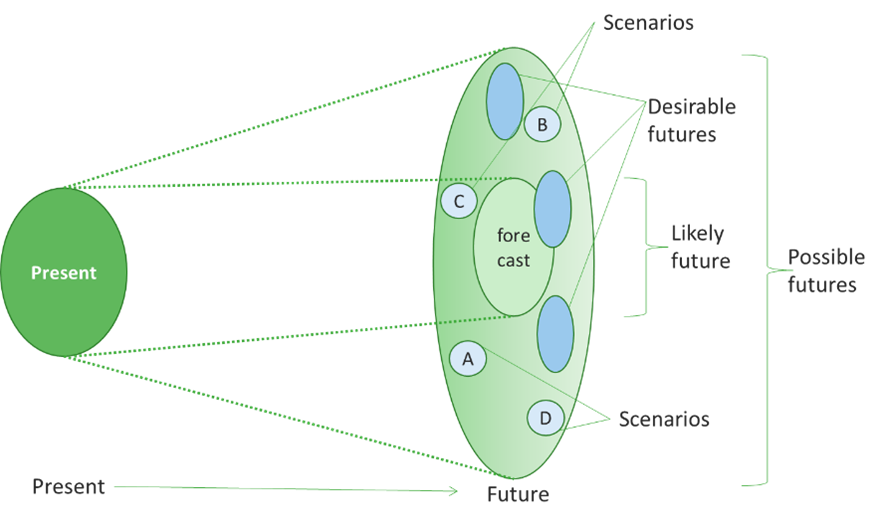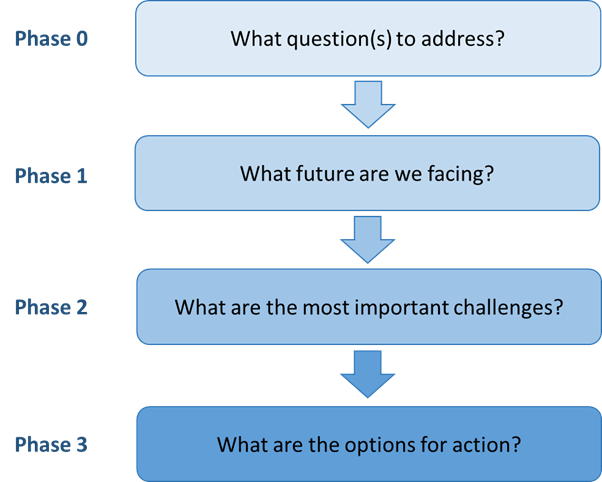In this chapter
Strategic (public health) foresight is important because it helps society and policymakers to anticipate future challenges and opportunities, rather than just reacting to problems as they arise. It can support being better prepared for emerging health risks such as pandemics, climate change effects, or new diseases before they become widespread problems.
It can also help for better resource allocation. By investing in, for example, prevention, health risks such as smoking or overweight might be mitigated. Also to anticipate increasing future pressures on the health system, for example with potentially increasing shortages of health personnel, decisions might be taking more timely. While the future is always subject to uncertainty, strategic foresight reduces surprises and helps manage risks more effectively. Therefore, it is good to apply a systematic way to look at the future.
Figure: Foresight cone tot systematically look at the future
The Netherlands in general has a longstanding tradition of doing foresight studies. RIVM is already more than 30 years making the Dutch Public health foresight study.
This experience build a strong basis of foresight expertise especially in the field of public health. Also in other research fields, RIVM is becoming more active in doing foresight studies, indicating a growing wish of future thinking. The COVID-19 pandemic further fuelled this wish.
There is no blueprint for doing a foresight study. Each topic and study has its own characteristics and research question that requires often a more tailer-made approach. However, there are common elements in many foresight approaches. In addition, we see a growing interest in foresights studies, and with that a growing need to be guided through the various steps of doing a foresight study. Foresight having a strong craft work nature, and the lack of having a scientific discipline for foresight, leaves many puzzled in how to conduct a foresight study. Therefore, we assimilated this report that helps people who want to conduct a foresight study but are not yet completely familiar with all facets involved. We distinguish four phases of a strategic foresight study that serve as the main structure of this website (see figure).
Figure: General setup of a foresight study
There is a variety of terminology referring to “looking into the future”
Future studies, outlooks, forecast, strategic planning, change management, forecasting, and design thinking are then terms used, with an overlap but also their own characteristics. Futurology as an overarching term, is defined as the "study of the future" first used by Flechtheim in the mid-1940s, who proposed it as a new branch of knowledge that would include a new science of probability. Before that, there were some remarkable examples of people describing and depicting the future.
The speculative fiction of H.G Wells being the author of e.g. War of the Worlds, is a striking example of addressing future challenges and looking for solutions for these challenges. With Herman Kahn and the RAND corporation, future studies became a common practice in many fields, starting with the military. In futurology, the term foresight has become widely used to describe activities such as 1) critical thinking concerning long-term developments, 2) debate and for some futurists who are normative and focus on action driven by their values who may be concerned with effort to create wider participatory democracy. Foresight is a set of competencies and not a value system, however and 3) shaping the future, especially by influencing public policy.
The foresight of futurology is also known as strategic foresight
However, the terminology to define different types of foresight, including strategic foresight, is not unambiguous. There are several ways to classify these different types. For example, you can distinguish:
- Strategic Foresight is a structured approach aimed at anticipating future trends, challenges, and opportunities to help organizations create tailored strategies and adapt to potential disruptions.
- Participatory Foresight is inclusive and collaborative, emphasizing the involvement of a wide range of stakeholders (e.g., citizens, experts, policymakers, marginalized groups) in thinking about and shaping the future. It prioritizes diverse voices and interests in the foresight process.
- Narrative Foresight is an approach that explores the powerful role of stories (or narratives) in shaping how individuals, organizations, and societies perceive, imagine, and act toward the future. It combines principles from foresight studies with the understanding that the stories we tell significantly influence our expectations, decisions, and strategies for the future.
- Normative Foresight is a future-oriented approach focused on defining and achieving desirable futures. It emphasizes envisioning what the future should look like based on values, goals, and shared aspirations, and then working backward to identify pathways and strategies to realize that future.
- Transformative Foresight is a type of foresight that focuses on enabling deep, systemic, and sustained change in response to major societal challenges. It is future-focused but explicitly aimed at cultivating transformative capacities to address complex, interconnected global issues such as climate change, inequality, or social injustice.
- Visionary Foresight is a type of foresight that focuses on imagining and articulating bold, inspiring, and desirable visions of the future. The emphasis is on creating a compelling and optimistic picture of what the future could look like if certain aspirations, values, and goals are realized.
- Revolutionary Foresight focuses on radical and disruptive change, questioning existing systems, structures, and power dynamics. It explores how progress or innovation can completely overhaul current norms and paradigms, imagining futures where society is fundamentally restructured.
- Creative Foresight is an approach to futures thinking that emphasizes imagination, innovation, and artistic exploration to envision new and unconventional possibilities for the future. It leverages human creativity to push beyond traditional methods of problem-solving and forecasting, often generating futures that are bold, imaginative, and unconstrained by current realities.
This categorization is not mutually exclusive. The focus here is on strategic foresight since it includes a strong link to strategies, such as policy making processes. It will however, have many overlapping facets such as participatory and/or normative elements.
Here a foresight approach refers to the way of conducting a foresight study, foresight methods are then elements of the approach.
Foresight uses a range of methodologies, such as horizon scanning, identifying megatrends and developing scenarios. Tools refers then to a further concretization of the methodology. To give an example. A foresights approach could be to develop scenarios regarding the prevalence and impacts of dementia. Modelling can then be the method employed, and a micro simulation model can be the tool to do so. The choice for the approach and methods applied is not always explicitly described.
Strategic foresight is a systematic and proactive approach to exploring and anticipating future trends, challenges, and opportunities in order to inform and guide decision-making and strategy development.
It involves using a combination of tools and methods, such as scenario planning, trend analysis, and stakeholder engagement, to gain a deeper understanding of the complex and uncertain forces shaping the future, and to develop actionable insights and recommendations for organizations.
We use the following definition: “Strategic Foresight is a systematic, participatory, future intelligence gathering and medium to long term scenario building process aimed at enabling present day decisions and mobilizing joint actions.”
All the facets included in this definition have a deeper meaning. We will briefly elaborate on the
- Systematic: a foresight study should methodological sound and systemic by applying for example the 6-step scenario building approach (ref tutorial) or other systematic approaches;
- Participatory: involvement of relevant stakeholders based on a structured participation process (see for example (Tuinstra, MNP)
- Future intelligence: use state-of-the-art knowledge and methods (quantitative and qualitative) to gain insights into the future. This requires an open view on innovative methods (see e.g. Popper)
- Medium to long-term: we do not predict the future but try to foresee what we might be facing, addressing associated uncertainty.
- Scenario: a scenario is a coherent, internally consistent, systematic and plausible description of a possible future state of the world
- Present day decisions and mobilizing joint actions: the objective is to support foresight-informed policy making. Knowledge translation is therefore an essential element in a foresight study.
An alternative way of looking at foresight is to see it as a process which combines three fundamental elements: prospective (long-term or forward-looking) approaches, planning (including policy-making and priority-setting) approaches, and participative approaches (engaging stakeholders and knowledge sources).
The future is uncertain and uncertainty is at the core of foresight.
However, uncertainty can be incorporated in different ways in a foresight study. Most foresight studies include the so-called cognitive uncertainty, uncertainty that stems from a lack of knowledge or understanding of a current or future situation.
It is a type of uncertainty that arises from gaps in our knowledge or understanding of a particular issue or problem, which is typically the case for future developments. It can be addressed through research, data collection, and analysis, though you should realize that all this evidence only strengthens the understanding of current situation, and is not automatically valid for future situations.
Technological progress is a good example of cognitive uncertainty. Its future evolvement and how it will influence society, is highly uncertain. Normative uncertainty, on the other hand, is a type of uncertainty that arises from a differences in what people value most and their underlying norms.
There is in general a lack of consensus about what is acceptable or unacceptable, desirable or undesirable. People have different perspectives on what they would like to see or to be achieved in the future as well. The political landscape is a good example of how these different perspectives work out in practice. Foresight studies can include both aspects of uncertainty.
Foresight versus forecast
A forecast reflects the most likely future based on data and past trends, also sometimes referred to as a prediction.
It is typically a more quantitative estimate of what is expected to happen in the near future.
For example, a weather forecast predicts the temperature, precipitation, and other meteorological conditions for a specific location in the future. Foresight, on the other hand, refers to the ability to see or anticipate future events and developments. It is a more qualitative and strategic approach to thinking about the future, and often involves scenario planning and strategic thinking.
Foresight helps organizations, governments, and individuals to proactively prepare for potential future events, both positive and negative, and make informed decisions. Where forecast focusses on certainty, foresights has uncertainty as the focal point.
There are many different methods available that can be applied within foresight.
These can be, for example, more qualitative or quantitative in nature, differ regarding involvement of stakeholders, more creative and inspiring or more evidence-based.
The choice for which methods to use depends on the issue at hand, but more important, it depends on the question to be addressed by the foresight study. A more visionary foresight study will ask for different methods than a foresight study aiming at demographic changes of populations. Next, some studies might focus or be limited to horizon scanning, and not include scenarios, while others might include various policy scenarios.
The foresight that we focus on right here follows the working definition as given before. This implies that we regard foresight approaches that are long-term, include elements such as scenarios and (policy) options, and also that have participatory elements, for example, stakeholder engagement.


